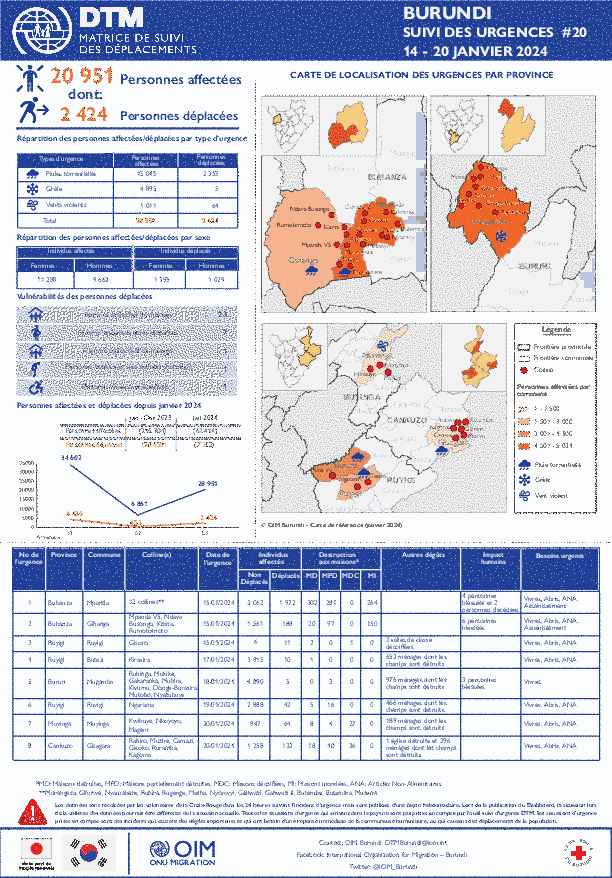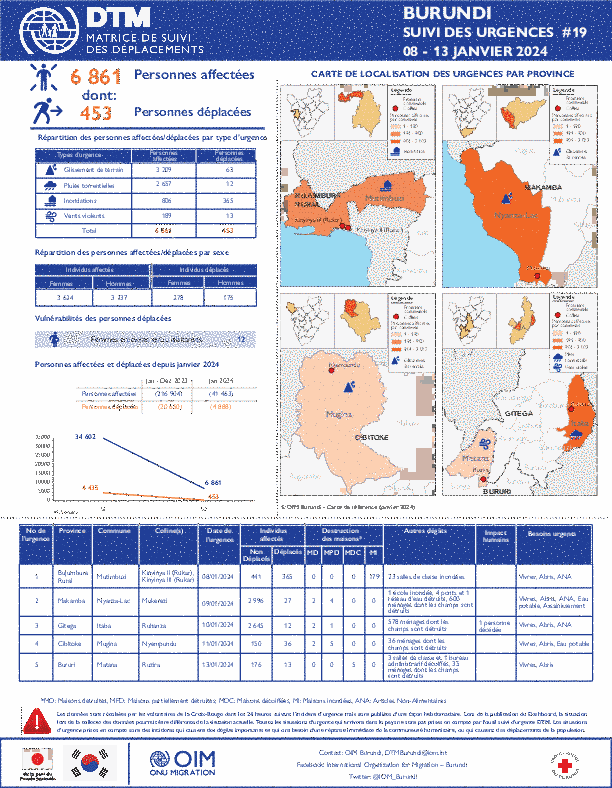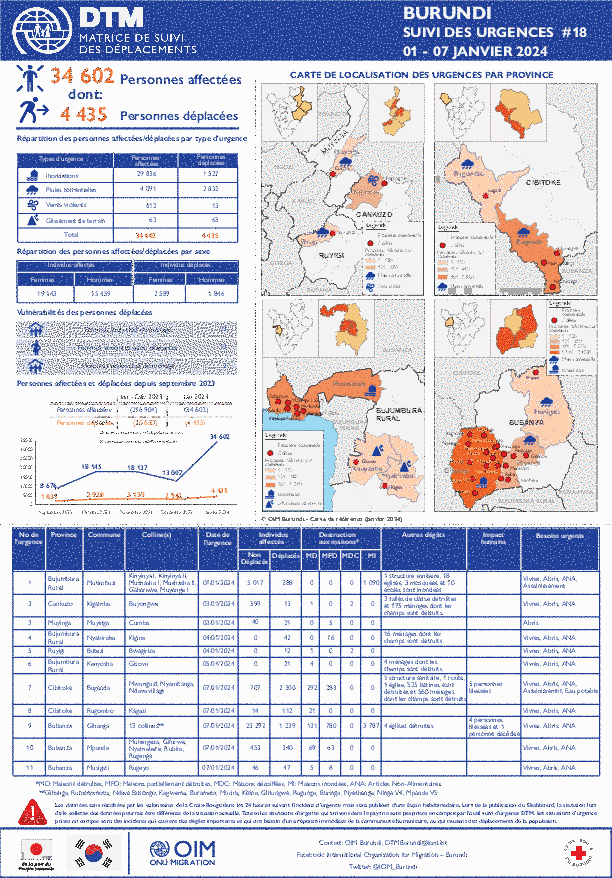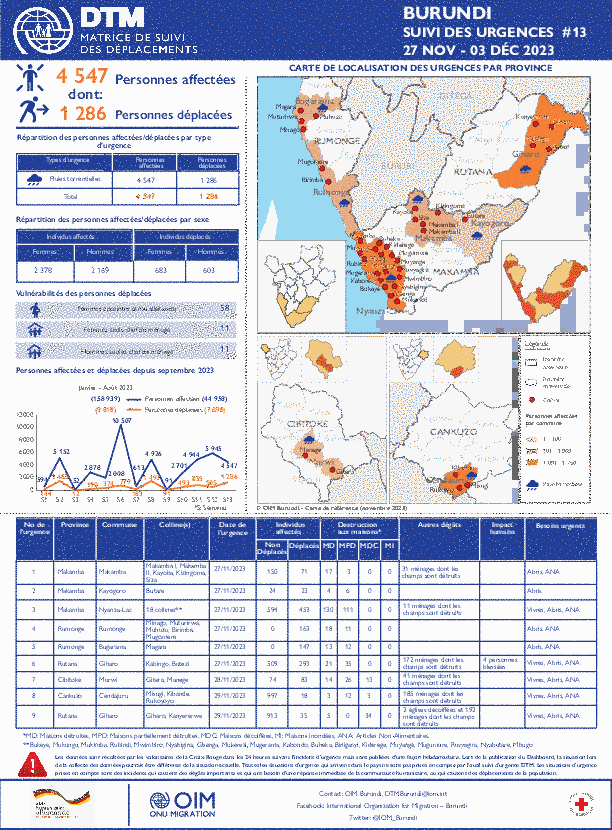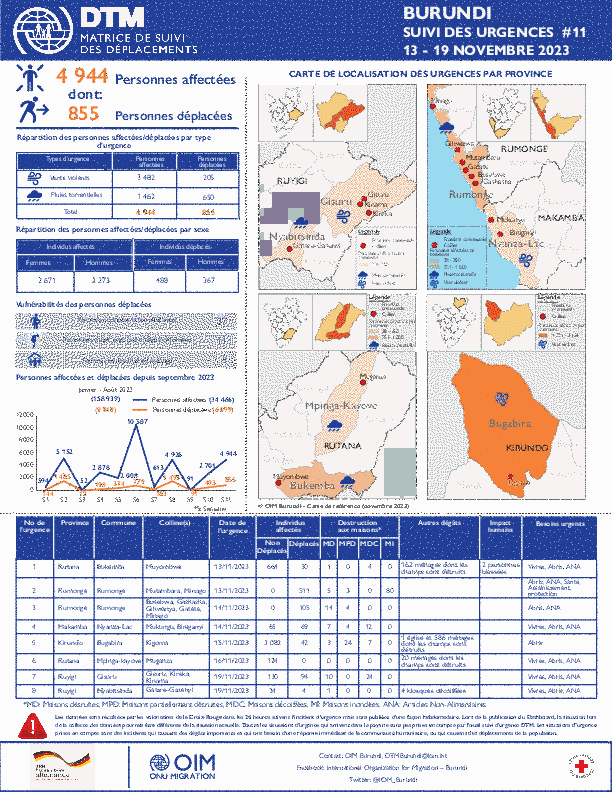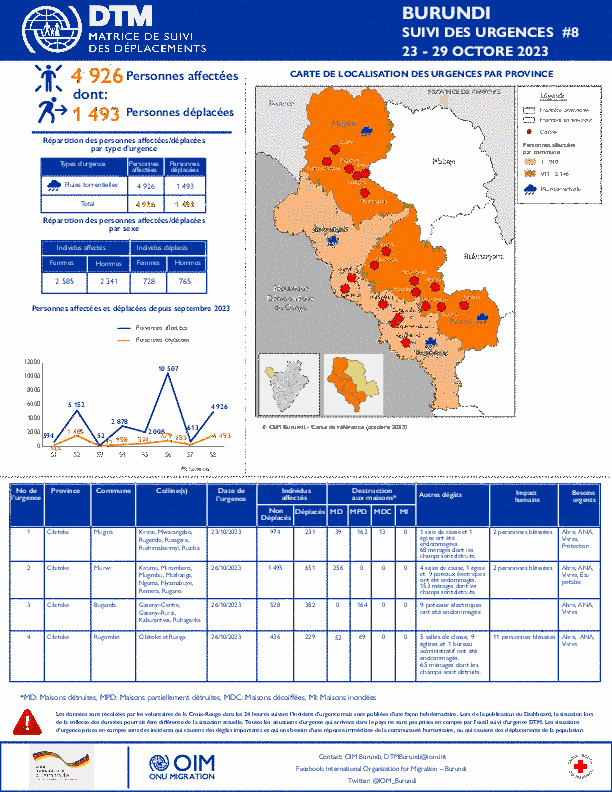-
Countries
-
Data and Analysis
-
Special Focus
-
Crisis Responses
Burundi
Burundi
IDPs tracked
Displacement Movements
8,100
IDMC 2023
Data collection round
About Burundi
In response to the great need for information on internally displaced persons (IDPs), their humanitarian profile and needs, as identified by the humanitarian community and the Burundian authorities, the International Organization for Migration (IOM) implemented DTM since 2015 to effectively and systematically track and assess internal population flows in Burundi and therefore provide reliable information on the current situation of IDPs.
The Displacement Tracking Matrix monitors IDPs on a national level and to identify their humanitarian needs. The DTM’s main objective is to maintain a comprehensive system of data collection and sharing on IDPs. The project relies on the synergy between IOM's DTM and the Burundi Red Cross (BRC), who are jointly responsible for data collection on internally displaced persons. The collected data includes figures on displacement, as well as displacement centres, provenance locations, approximate duration of displacement and humanitarian needs of the displaced populations. The information collected at various levels contributes to the construction of an overall profile of the displaced population in targeted provinces, which can then be used by the government and the humanitarian partners in order to protect, assist and advocate for IDPs.
In November 2018, DTM Burundi also began to collect data on movement at unofficial points of transit on the Burundi - Tanzania border. The information collected at the flow monitoring points enable the government, humanitarian partners and policy stakeholders, to understand migration trends on the national and regional levels.
Contact
DTMBurundi@iom.int
Current Donors
- PRM
- BHA
- Japan
- Republic of Korea
- Swiss (SDC)
- GFFO
Aperçu du changement climatique et des catastrophes (2018 - 2023)
Depuis 2018, le changement climatique et les catastrophes, en particulier les pluies torrentielles, les inondations et les vents violents survenus au Burundi ont affecté 646 018 personnes dont 145 183 personnes déplacées.
Burundi - Suivi des urgences (21 - 27 janvier 2024)
La DTM a identifié 2 785 personnes affectées, dont 141 personnes déplacées par les pluies torrentielles et la grêle dans les provinces de Cankuzo, Kayanza, Gitega, Rutana et Makamba.
Burundi - Suivi des urgences (14 - 20 janvier 2024)
La DTM a recensé un total de 20 951 personnes affectées et 2 424 personnes déplacées en raison de diverses urgences survenues en Burundi.
Burundi - Suivi des urgences (17 - 23 décembre 2023)
La DTM a identifié 1 030 personnes affectées, dont 123 personnes déplacées par les vents violents et les pluies torrentielles dans les provinces de Cibitoke, Makamba, Muyinga et Bururi.
Burundi - Suivi des urgences (24 - 31 décembre 2023)
La DTM a identifié 10 767 personnes affectées, dont 2 010 personnes déplacées par les pluies torrentielles, les vents violents et les glissements de terrain dans les provinces de Bujumbura Mairie, Bujumbura Rural, Bururi et Makamba.
Burundi - Suivi des urgences (8 - 13 janvier 2024)
La DTM a identifié 6 861 personnes affectées, dont 453 personnes déplacées par les glissements de terrain, les pluies torrentielles, les inondations et les vents violents dans les provinces de Bujumbura Rural, Makamba, Gitega, Cibitoke et Bururi.
Burundi - Suivi des urgences (1 - 7 janvier 2024)
La DTM a identifié 34 602 personnes affectées dont 4 435 personnes déplacées par les pluies torrentielles dans les provinces de Bujumbura Rural, Cankuzo, Muyinga, Ruyigi, Cibitoke, et Bubanza.
Burundi – Rapport de profilage (Commune Mutimbuzi) (Novembre 2023)
Depuis 2020, la province de Bujumbura Rural, commune de Mutimbuzi, zone de Gatumba a été récurremment touchée par de fortes inondations affectant plusieurs milliers de personnes.
Burundi — Suivi des urgences (04 au 09 Décembre 2023)
La DTM a identifié 294 personnes affectées dont 93 personnes déplacées par les pluies torrentielles dans les provinces de Rutana et Makamba.
Burundi – Indice de Stabilité Round 2 (Janvier- Juin 2023)
L’Indice de Stabilité comprend des données recueillies lors d’entretiens avec des informateurs clés au niveau local dans les provinces cibles touchées par le déplacement interne et les mouvements de retour des réfugiés burundais des pays voisins.
Burundi – Stability Index Round 2 (January-June 2023)
The Stability Index includes data collected through interviews with key informants at the local level in the target provinces affected by internal displacement and return movements of Burundian refugees from neighbouring countries.
Burundi — Suivi des urgences (27 Novembre au 03 Décembre 2023)
La DTM a identifié 4 547 personnes affectées dont 1286 personnes déplacées par les pluies torrentielles dans les provinces de Rutana, Rumonge, Makamba, Cibtoke et Cankuzo
Burundi — Suivi des urgences (13 au 19 novembre 2023)
La DTM a identifié 4 944 personnes affectées (942 ménages) dont 855 personnes déplacées (150 ménages) par les pluies torrentielles et les vents violents dans les provinces de Rutana, Rumonge, Makamba, Kirundo, et Ruyigi.
Burundi — Suivi des urgences (20 au 26 novembre 2023)
La DTM a identifié 5 945 personnes affectées (1136 ménages) dont 505 personnes déplacées (82 ménages) par les pluies torrentielles et les inondations dans les provinces de Kayanza, Rutana, Muramvya, Bujumbura Mairie, Gitega, et Cankuzo.
Burundi — Suivi des urgences (06 au 12 novembre 2023)
La DTM a identifié 2 701 personnes affectées (470 ménages) dont 493 personnes déplacées (86 ménages) par les pluies torrentielles et les inondations dans les provinces de Bubanza, Bujumbura Mairie et Rutana.
Burundi — Suivi des urgences (30 Octobre - 05 Novembre 2023)
La DTM a identifié 91 personnes affectées dont 91 personnes déplacées par les vents violents dans les provinces de Rumonge.
Burundi — Suivi des urgences (25 Septembre - 02 Octobre 2022)
La DTM a identifié 5,370 personnes affectées dont 249 personnes déplacées par les vents violents et des pluies torrentielles dans les provinces de Mwaro, Kirundo, Bujumbura Mairie, Bururi, Cankuzo et Makamba.
Burundi — Suivi des urgences (23 - 29 Octobre 2023)
La DTM a identifié 4,926 personnes affectées dont 1,493 personnes déplacées par les vents violents et des pluies torrentielles dans les provinces de Mwaro, Kirundo, Bujumbura Mairie, Bururi, Cankuzo et Makamba.
Burundi — Suivi des urgences (15 - 22 Octobre 2023)
La DTM a identifié 613 personnes affectées dont 183 personnes déplacées par les vents violents et des pluies torrentielles dans les provinces de Mwaro, Kirundo, Bujumbura Mairie, Bururi, Cankuzo et Makamba.
Burundi — Suivi des urgences (08 - 15 Octobre 2023)
La DTM a identifié 10 507 personnes affectées dont 779 personnes déplacées par les vents violents et des pluies torrentielles dans les provinces de Mwaro, Kirundo, Bujumbura Mairie, Bururi, Cankuzo et Makamba.
Burundi — Suivi des urgences (01-07 Octobre 2023)
La DTM a identifié 2 008 personnes affectées dont 374 personnes déplacées par les vents violents et des pluies torrentielles dans les provinces de Cibitoke et Kirundo.
Evaluation du progrès vers une solution durable: Commune Nyanza-lac de Makamba
En décembre 2022, une évaluation a été menée auprès des informateurs-clés pour renseigner sur la stabilité de 50 collines où se trouvent concurremment un grand nombre de personnes déplacées internes (PDI) et rapatriées provenant de six communes de la province de Makamba.
Evaluation du progrès vers une solution durable: Commune Giteranyi de Muyinga
En décembre 2022, une évaluation a été menée auprès des informateurs-clés pour renseigner sur la stabilité de 62 collines où se trouvent concurremment un grand nombre de personnes déplacées internes (PDI) et rapatriées provenant de sept communes de la province de Muyinga.
Evaluation du progrès vers une solution durable: Commune Gisuru de Ruyigi
En décembre 2022, une évaluation a été menée auprès des informateurs-clés pour renseigner sur la stabilité de 70 collines où se trouvent concurremment un grand nombre de personnes déplacées internes (PDI) et rapatriées provenant de sept communes de la province de Ruyigi.
Pagination
Burundi — Baseline Assessment — Round 71
2023-03-17
From 1-7 March 2023, the DTM team in Burundi conducted the 71st round of Baseline assessment in 1,353 Collines (Administrative Boundary level 3) and identified 73,586 internally displaced persons (IDPs) in 16,690 households. . Nearly all displacements were due to natural disasters (89%) and 11%…
Burundi — Données de Suivi des Urgences — (05 - 11 Mars 2023)
2023-03-11
Activated on an ad hoc basis, the DTM Emergency Tracking provides early field reports at the beginning of a complex crisis, allowing IOM to gather, consolidate and disseminate baseline information on displacement and return figures at the onset of a newly emerging crisis. The DTM Emergency Tracking…
Burundi — Données de Suivi des Urgences — (26 Février - 04 Mars 2023)
2023-03-04
Activated on an ad hoc basis, the DTM Emergency Tracking provides early field reports at the beginning of a complex crisis, allowing IOM to gather, consolidate and disseminate baseline information on displacement and return figures at the onset of a newly emerging crisis. The DTM Emergency Tracking…
Burundi — Données de Suivi des Urgences — (19 - 25 Février 2023)
2023-02-25
Activated on an ad hoc basis, the DTM Emergency Tracking provides early field reports at the beginning of a complex crisis, allowing IOM to gather, consolidate and disseminate baseline information on displacement and return figures at the onset of a newly emerging crisis. The DTM Emergency Tracking…
Burundi — Données de Suivi des Urgences — (12 - 18 Février 2023)
2023-02-18
Activated on an ad hoc basis, the DTM Emergency Tracking provides early field reports at the beginning of a complex crisis, allowing IOM to gather, consolidate and disseminate baseline information on displacement and return figures at the onset of a newly emerging crisis. The DTM Emergency Tracking…
Burundi — Données de Suivi des Urgences — (06 - 11 Février 2023)
2023-02-11
Activated on an ad hoc basis, the DTM Emergency Tracking provides early field reports at the beginning of a complex crisis, allowing IOM to gather, consolidate and disseminate baseline information on displacement and return figures at the onset of a newly emerging crisis. The DTM Emergency Tracking…
Burundi — Suivi des urgences - (22 - 28 Janvier 2023)
2023-01-28
Activated on an ad hoc basis, the DTM Emergency Tracking provides early field reports at the beginning of a complex crisis, allowing IOM to gather, consolidate and disseminate baseline information on displacement and return figures at the onset of a newly emerging crisis. The DTM Emergency Tracking…
Burundi — Données de Suivi des Urgences — 15 - 21 Janvier 2023
2023-01-21
Activated on an ad hoc basis, the DTM Emergency Tracking provides early field reports at the beginning of a complex crisis, allowing IOM to gather, consolidate and disseminate baseline information on displacement and return figures at the onset of a newly emerging crisis. The DTM Emergency Tracking…
Burundi — Données de Suivi des Urgences — (08- 14 Jan 2023)
2023-01-14
Activated on an ad hoc basis, the DTM Emergency Tracking provides early field reports at the beginning of a complex crisis, allowing IOM to gather, consolidate and disseminate baseline information on displacement and return figures at the onset of a newly emerging crisis. The DTM Emergency Tracking…
Burundi — Données de Suivi des Urgences — (25 - 31 Dec 2022)
2022-12-31
Activated on an ad hoc basis, the DTM Emergency Tracking provides early field reports at the beginning of a complex crisis, allowing IOM to gather, consolidate and disseminate baseline information on displacement and return figures at the onset of a newly emerging crisis. The DTM Emergency Tracking…
Burundi — Données de Suivi des Urgences — (18 - 24 Dec 2022)
2022-12-24
Activated on an ad hoc basis, the DTM Emergency Tracking provides early field reports at the beginning of a complex crisis, allowing IOM to gather, consolidate and disseminate baseline information on displacement and return figures at the onset of a newly emerging crisis. The DTM Emergency Tracking…
Burundi — Données de Suivi des Urgences — (11 - 17 Dec 2022)
2022-12-17
Activated on an ad hoc basis, the DTM Emergency Tracking provides early field reports at the beginning of a complex crisis, allowing IOM to gather, consolidate and disseminate baseline information on displacement and return figures at the onset of a newly emerging crisis. The DTM Emergency Tracking…
Burundi — Données de Suivi des Urgences — (04 - 10 Dec 2022)
2022-12-10
Activated on an ad hoc basis, the DTM Emergency Tracking provides early field reports at the beginning of a complex crisis, allowing IOM to gather, consolidate and disseminate baseline information on displacement and return figures at the onset of a newly emerging crisis. The DTM Emergency Tracking…
Burundi — Données de Suivi des Urgences — (28 Nov - 03 Dec 2022)
2022-12-03
Activated on an ad hoc basis, the DTM Emergency Tracking provides early field reports at the beginning of a complex crisis, allowing IOM to gather, consolidate and disseminate baseline information on displacement and return figures at the onset of a newly emerging crisis. The DTM Emergency Tracking…
Burundi — Données de Suivi des Urgences — 21 Nov au 27 Nov 2022
2022-11-27
Activated on an ad hoc basis, the DTM Emergency Tracking provides early field reports at the beginning of a complex crisis, allowing IOM to gather, consolidate and disseminate baseline information on displacement and return figures at the onset of a newly emerging crisis. The DTM Emergency Tracking…
Burundi — Données de Suivi des Urgences — 07 Nov au 13 Nov 2022
2022-11-13
Entre le 7 et le 13 novembre 2022, la DTM a identifié 88 personnes affectées, dont 70 personnes déplacées, par des pluies torrentielles et vents violents dans les provinces de Ruyigi, Bururi et Makamba.
Burundi — Données de Suivi des Urgences — 31 Oct au 06 Nov 2022
2022-11-06
Activated on an ad hoc basis, the DTM Emergency Tracking provides early field reports at the beginning of a complex crisis, allowing IOM to gather, consolidate and disseminate baseline information on displacement and return figures at the onset of a newly emerging crisis. The DTM Emergency Tracking…
Burundi — Données de Suivi des Urgences — 24 au 30 Octobre 2022
2022-10-30
Activated on an ad hoc basis, the DTM Emergency Tracking provides early field reports at the beginning of a complex crisis, allowing IOM to gather, consolidate and disseminate baseline information on displacement and return figures at the onset of a newly emerging crisis. The DTM Emergency Tracking…
Burundi — Données de Suivi des Urgences — 17 au 23 Octobre 2022
2022-10-23
Activated on an ad hoc basis, the DTM Emergency Tracking provides early field reports at the beginning of a complex crisis, allowing IOM to gather, consolidate and disseminate baseline information on displacement and return figures at the onset of a newly emerging crisis. The DTM Emergency Tracking…




